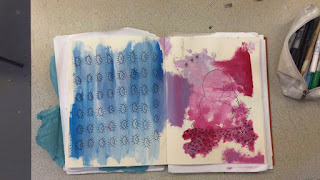the importance of the
creative industry
rebellion
power
money etc
keneth clark - art
exhibition to london during the war - promoting art – Churchill
Fight for freedom of Mind -
opposite to degenerate - individuality
same thing happening now
2500 words
The Sad, Strange Story of “Degenerate Art” VS
The Fight for Freedom of Mind
A war on the
modern imagination
Degenerate Art
As
you may very well know, the fevered brain of an art-obsessed Adolf Hitler aimed
to show not only that Jewish and Bolshevik art was a disgrace; he also argued
that the degeneracy of those artists threatened the health of the rest of the
population. That the “master race” whom Hitler believed should rule the world,
ultimately with him as the leader should abolish all things that were not up to
his standard of perfection.
To be able to talk about the peril Hitler caused
I think you've got to first start with what caused him to do this. All the way back
to the turn of the century. Hitler was an artist himself who was sent to war.
He was of no particular importance during the war, just another soldier
fighting a never-ending battle but nevertheless he was a man with a mission
after that. I think war can ruin anyone, especially trench warfare, surrounded
by bodies for a year will do that to a person. But it effects someone so much
more when they have a 'soft soul' and are much more sensitive than others (artists,
musicians etc...) and that’s what it did to Hitler. He said 'hatred ruined me' and I think that
simple sentence perfectly describes exactly what the war did to him. That and
his imprisonment, which I will come to later. After the war Hitler resolved to
go into politics.
In the 1920's the Nazis were a small group,
which held no fear towards the expressionists, few people cared about Hitler
and his fanatic ideas. It wasn't until Germanys fragile democracy was in
turmoil that the people started to take note of what Hitler was saying. Berlin
flourished at the time and it was a center for art and all things 'degenerate'.
In 1924 Hitler was released from his imprisonment which he then blamed on Jews,
communists, degenerates, he labeled expressionists 'artists like the mentally
ill'. Hitler’s break was the great depression. He thought that there was a 'sickness
in society' all caused by degenerates, that they were affecting the pure
race and even the culture.
Gradually as Hitler rose to power, where he attempted
to 'cleanse' the nation of degenerates (artists, communists, Jews, Bolsheviks) to wipe them all out to
become the purest race. Hitler made it so it was a science in the decision of
who was a degenerate; there were symptoms and observations to be made.
Basically what it came down to is if you didn't look a certain way you were a
degenerate.
In 1933 Hitler was appointed chancellor as the
fragile German democracy was near death. Hitler was in power less than 5 months
when the Berlin book burnings came about and the war on modern imagination
really started. Even artists who stood by the Nazis were turned against. All
forms of modern art were slandered. Hitler resolved to create a new world with
no place for the weak or sensitive minds. Many artists emigrated to save
themselves, although some stayed. One man said 'I painted landscapes as that
was tantamount to immigration'. Paintings were confiscated and people then
painted in water colour because if they painted in oils you could smell it and
they were afraid of the outcome had anyone known what they 'were'/were doing.
The degenerate art show was created to purposely
slander modern art. It was described as a horror
show. It was claustrophobic, the lighting was terrible, there was graffiti
ridiculing the artwork. What was not long ago seen as amazing new innovative
art, painted by amazing, famous artists was now mocked. Artists were now
criminals or 'Jews'.
The exhibition presented 650 different works of
art from a variety of artists such as, Georg Grosz, Ernst Ludwig Kirchner, Emil
Nolde and many others.
Ernst was a German expressionist painter and a
printmaker. He was also a key founder of a group called The Bridge, which led
to the foundation of Expressionism in 20th century art! Sadly, after his endeavor
in the First World War he suffered a breakdown and was discharged. Ernst's life
spiraled from there as when Hitler came to power his work was branded
'degenerate' and over 600 of his works were sold or destroyed. In 1938 Ernst
committed suicide.
Otto Dix was yet another classed as a degenerate
artist that's lifestyle was taken when the Nazis came to power in Germany.
Firstly Dix was sacked from his post as an art teacher, later his paintings
like; The Trench and War Cripples were exhibited in the exhibition of
degenerate art and later burned. Dix like a lot of other practicing artists was
forced into promising into only painting inoffensive landscapes. Dix still
painted the occasional painting in his own style that the Nazi's criticized. In
1939 he was arrested on a charge of being involved in a plot against Hitler but
was later released.
Max Beckmann luck changed with the rise of the
Nazis. There dislike of modern art quickly deteriorated his life. In 1933 the
Nazi government called Beckmann a "cultural Bolshevik" and he was
then dismissed from his teaching position (much like Otto Dix). His work was
confiscated and also put on display in the Degenerate Art exhibition, this led
Beckmann to relocating himself and his second wife to the Netherlands.
The day before the degenerate art show started
Hitler delivered a speech declaring a "merciless war" of destruction
against the last remaining elements of cultural disintegration. Hitler said
"works of art which cannot be understood in themselves but need some pretentious
instruction book to justify their existence will never again find their way to
the German people."
There were so many artists affected by the
Nazi's ruling and many either fled the country or killed themselves. One million
people attended the show in its first six weeks. The art show toured for four
years and caused the death of art in Germany.
The
result of the degenerate art show is a sad history that will leave you shaking
your head at the past, wondering how that could of happened. But also make you
think, could this happen again? Here and now.
Kenneth Clark
– A civilised man
Fight for
Freedom of Mind
Clark
was and still is widely seen as one of the most influential figures in British
art of the twentieth century. He was a man of many talents, a patron, a collector,
art historian, public servant and broadcaster. Many will know who Clark is for
being the maker of pioneering a TV series that was broadcasted internationally,
the most famous of them being Civilisation
(1969).
During
the 1930s and 40s he was a leading supporter and promoter of contemporary
British arts and artists. Kenneth Clark was hardly a man of the people. Being
born into a filthy rich family, living in a castle and mostly putting himself
across as far too grand, aloof and chilly towards others, it didn’t create him
as the perfect candidate for a supporter of the arts; nevertheless, here he
was, using his wealth and influences to become an early advocate of supporting
the arts. He passionately believed galleries should be “to make art as
accessible and understandable to as many people as possible”. Clark would buy
works of art from those he admired and he would also provide financial support
to them allowing artists to work freely, offered commissions and also worked
towards helping artist’s work to be entered into prestigious collections. He
believed that a crisis in patronage had led artists to become too detached from
the rest of society, so to rectify this he promoted a representational art that
was both modern and rooted in tradition. The best of both worlds. Clark was an
activist of his time; he was vigorous in campaigning to bring social change
towards artists.
This
was all happening during the war, the exact time Hitler was destroying a
nation. The reason I chose to speak of Clark is because he was quite literally
the complete opposite of Hitler. Where Hitler would slander art and class it as
degenerate turning a nation against specific arts, Clark vocalized the
importance of art and the individuality. What amazes me is how this was
happening in the same time period of each other in countries not that far
apart. That a man who most people would of claimed to be an arrogant snob would
actually be a saviour of art.
The importance
of the creative industry
The
UK currently is recognised globally for its creative industry, from advertising
to architecture to graphic design to photography. These are the roles that make
up the creative industry and consequently play the largest role in contributing
to the success in the economy.
The
creative industries account for 1.71 million jobs in 2013, that’s 5.6%
of all jobs in the UK. We also generated £76.9 billion in the output of
the UK.
The
creative industries are an engine of growth for the UK economy; it is vital to
pay attention to a thriving sector such as this.
The
past is the past for a reason, I do believe we should learn from the past to
not repeat the same mistakes. Although we acknowledge the importance of the industry now it still isn't as highly regarded as it should be. Even with mistakes in the past being so drastic and life altering we continue to not learn from it.
Will the same thing happen now?



























































































































